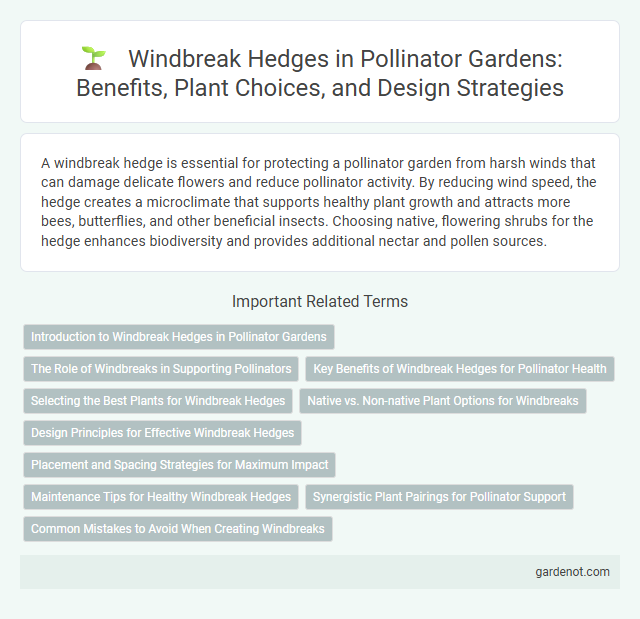A windbreak hedge is essential for protecting a pollinator garden from harsh winds that can damage delicate flowers and reduce pollinator activity. By reducing wind speed, the hedge creates a microclimate that supports healthy plant growth and attracts more bees, butterflies, and other beneficial insects. Choosing native, flowering shrubs for the hedge enhances biodiversity and provides additional nectar and pollen sources.
Introduction to Windbreak Hedges in Pollinator Gardens
Windbreak hedges in pollinator gardens serve as protective barriers that reduce wind speed, creating a more stable microclimate for pollinators like bees, butterflies, and hummingbirds. These dense plantings not only shield fragile flowers from harsh winds but also provide essential habitat and food sources, enhancing biodiversity. Selecting native, flowering shrubs for windbreak hedges ensures continuous nectar and pollen supply, supporting pollinator populations year-round.
The Role of Windbreaks in Supporting Pollinators
Windbreak hedges create a sheltered environment that reduces wind stress on pollinator habitats, enhancing the foraging efficiency of bees and butterflies. By mitigating harsh weather conditions, these hedges help maintain stable microclimates essential for pollinator activity and reproductive success. Strategic planting of windbreaks with native flora also provides additional food sources and nesting sites, supporting biodiversity in pollinator gardens.
Key Benefits of Windbreak Hedges for Pollinator Health
Windbreak hedges create a sheltered microclimate that protects pollinator habitats from harsh winds, increasing forager activity and reducing stress on beneficial insects. These hedges support biodiversity by providing diverse flowering plants and nesting sites, essential for sustaining robust pollinator populations. Enhanced pollination efficiency and greater crop yields result from the improved conditions created by these natural wind barriers.
Selecting the Best Plants for Windbreak Hedges
Selecting the best plants for windbreak hedges in a pollinator garden involves choosing native, dense, and tall species such as Eastern Red Cedar, American Holly, and Black Elderberry, which provide essential shelter and reduce wind speed to protect delicate flowers. Incorporating a mix of deciduous and evergreen shrubs maximizes year-round wind protection while supporting diverse pollinator habitats. Prioritize plants with fragrant blooms and abundant nectar sources like serviceberry and viburnum to enhance the garden's attractiveness to bees, butterflies, and other pollinators.
Native vs. Non-native Plant Options for Windbreaks
Native plants in windbreak hedges provide essential habitats for pollinators, supporting local biodiversity while enhancing garden resilience. Non-native plant options may offer rapid growth and aesthetic appeal but often lack the ecological benefits that native species deliver, potentially disrupting pollinator feeding and nesting patterns. Choosing native windbreak species ensures optimal shelter and forage for pollinators, promoting a healthy and sustainable pollinator garden ecosystem.
Design Principles for Effective Windbreak Hedges
Effective windbreak hedges in pollinator gardens incorporate dense, diverse plantings that reduce wind speed and create microclimates favorable to pollinators. Strategic layering of tall shrubs and trees with lower-growing flowering plants maximizes shelter while providing continuous forage sources. Optimal spacing ensures airflow without excessive wind tunneling, enhancing habitat stability and pollinator activity.
Placement and Spacing Strategies for Maximum Impact
Strategic placement of a windbreak hedge around a pollinator garden enhances protection from harsh winds, creating a microclimate that supports pollinator activity. Optimal spacing between hedge plants, typically 18 to 36 inches apart depending on species, ensures dense coverage without overcrowding, promoting healthy growth and stable wind barriers. Positioning the hedge on the garden's windward side maximizes shelter, while maintaining access paths encourages biodiversity and easy maintenance.
Maintenance Tips for Healthy Windbreak Hedges
Prune windbreak hedges annually to maintain dense growth and prevent gaps that reduce their effectiveness in protecting pollinator gardens. Regularly inspect for pests and diseases to address issues early and promote plant health. Water deeply during dry periods to ensure strong root development and increase the hedge's resilience against wind stress.
Synergistic Plant Pairings for Pollinator Support
Windbreak hedges composed of native shrubs like elderberry and serviceberry create microclimates that protect pollinator gardens from harsh winds while providing nectar and pollen sources. Pairing these hedges with flowering perennials such as coneflowers and bee balm enhances habitat diversity and foraging opportunities for bees, butterflies, and hummingbirds. Strategic plant combinations in windbreaks amplify pollinator support by increasing floral resource availability and shelter within garden ecosystems.
Common Mistakes to Avoid When Creating Windbreaks
Avoid planting dense, non-flowering species in windbreak hedges as they provide limited food resources for pollinators, reducing habitat value. Selecting inappropriate hedge height can either fail to reduce wind effectively or block sunlight essential for pollinator plants. Overlooking native plant species that support local pollinator populations undermines biodiversity and ecosystem health in windbreak gardens.
Windbreak hedge Infographic

 gardenot.com
gardenot.com